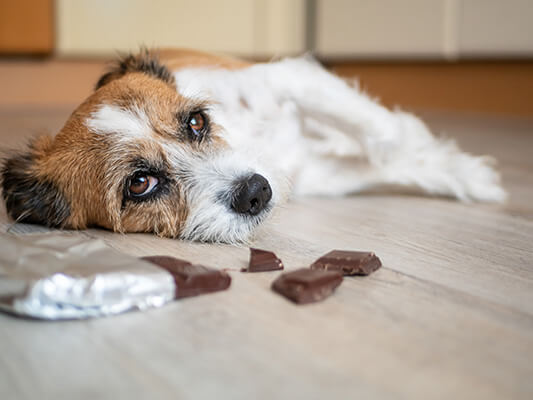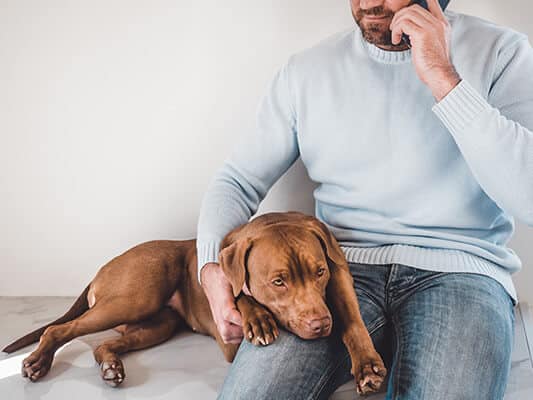Chocolate toxicity is a serious risk for dogs who eat brownies. The chocolate in brownies can cause severe health problems in dogs, and if your dog eats a brownie, you must act fast to get them treatment. We’ll cover the signs of chocolate poisoning, how much chocolate is dangerous, what to do if they eat other brownie ingredients, and when to call the vet. Dog owners can keep their dog safe if they accidentally eat chocolate brownies by staying informed.
What To Do If My Dog Eats A Brownie Key Takeaways
Remove any remaining brownies to prevent further ingestion.
Determine the number of brownies consumed and the type of chocolate.
Contact a veterinarian for guidance and assistance.
Induce vomiting if discovered within minutes.
The First Steps You Should Take After Your Dog Ate Chocolate Brownies
Now that your dog has eaten chocolate brownies, it’s important to take immediate action:
1. Remove The Brownies To Prevent Your Dog From Eating More
Move the remaining brownies to a safe place immediately to prevent your dog from eating more. Chocolate can be toxic to dogs, and the ingredients in brownies, such as cocoa powder and sugar, can be harmful to their health. Removing the brownies from your dog’s reach is critical to avoid further ingesting the toxic substance. Remember to keep your dog away from the area where the brownies were, as they may continue to search for more. Additionally, make sure to clean up any crumbs or remnants of the brownies to minimize the risk of accidental ingestion. If your dog has already consumed a significant amount of chocolate, it’s recommended to contact an emergency vet for guidance.
2. Figure Out How Many Your Dog Ate And The Type Of Chocolate Brownie That Was Ingested
To accurately assess the situation, determine the number of brownies your dog ingested and identify the type of chocolate brownie consumed. This information is important in understanding the potential level of toxicity and the appropriate steps to take. Different types of chocolate have varying levels of theobromine, the compound that can be toxic to dogs. Dark chocolate, baker’s chocolate, and cocoa powder contain higher amounts of theobromine compared to white chocolate or chocolate chips. If you have a small dog, even a small amount of dark chocolate or baker’s chocolate can be dangerous. Look for signs of chocolate poisoning, such as vomiting, diarrhea, rapid breathing, increased heart rate, and excessive thirst. Remember to contact your veterinarian immediately for further guidance based on the number and type of brownies your dog consumed.
3. If You Discover The Dog Ate The Brownie Within Minutes, Try To Make Them Vomit
If you discover your dog ate chocolate brownies very recently, the first step you can try is to make them vomit. This is important because chocolate contains toxic substances that can be harmful to dogs, especially in larger quantities or in severe cases. To induce vomiting, you can use hydrogen peroxide, which is a recommended method. The suggested dosage is one teaspoon per five pounds of the dog’s body weight. But, it’s important to consult with a veterinarian before administering any treatment as hydrogen peroxide may not be the safest treatment. Remember to keep your dog in a safe place during the vomiting process and monitor them closely for any clinical signs of distress.
4. Contact Your Vet
Contact your vet immediately after discovering your dog has eaten chocolate brownies for guidance and assistance. Purer chocolate can be toxic to dogs, and the severity of the situation depends on how much brownie was consumed and the type of chocolate the brownies were made from. By contacting your vet, you can inform them about your dog’s size, the type of chocolate in the brownie, and the quantity ingested. Your vet will be able to assess the potential risks and advise you on the necessary steps to take. They may recommend inducing vomiting, monitoring your dog for symptoms, or even bringing them in for a check-up. Remember, time is of the essence when it comes to chocolate toxicity, so don’t hesitate to contact your vet immediately. And if your pup dives into a chocolate snack at night or on the weekend, you can contact the Pet Poison Helpline at (855) 764-7661 for help and guidance.
How Many Brownies Can Dogs Eat?
You can determine the number of brownies that dogs can safely eat by considering their size and the type of chocolate used. It’s important to note that all types of chocolate contain toxic chemicals for dogs, so even a small amount can be harmful. Darker chocolates, such as cooking chocolate, have higher levels of toxic ingredients like theobromine and caffeine. The size of your dog also plays a role, as smaller dogs are more at risk if they consume chocolate. You can use a chocolate toxicity calculator or contact the Pet Poison Helpline for guidance in calculating the potential toxicity. If your dog has ingested a high dose of chocolate or is showing symptoms of chocolate toxicity, it’s crucial to seek veterinary care immediately. Don’t induce vomiting unless directed by a veterinarian, as hydrogen peroxide can be dangerous for older dogs. Pet owners should always be cautious and keep chocolate out of reach of their furry friends.
Signs Of Chocolate Toxicity

To recognize signs of chocolate toxicity in your dog, pay close attention to their behavior and physical symptoms. Chocolate poisoning can occur when dogs eat chocolate, which contains a compound called theobromine that’s toxic to them. The severity of the poisoning depends on the type and amount of chocolate ingested. Watch for symptoms such as vomiting, diarrhea, increased urination and drinking, restlessness, muscle tremors, seizures, or increased heart rate. These symptoms may not appear for up to 12 hours and can last for up to 72 hours after ingesting chocolate. If you suspect your dog has ingested chocolate or shows signs of poisoning, it’s important to contact your vet immediately or call a poison helpline. Remember that even small amounts of chocolate can be dangerous for dogs, so it’s crucial to be vigilant and seek prompt treatment.
What If My Dog Eats Other Brownie Ingredients?
If your dog eats other brownie ingredients, such as macadamia nuts, xylitol, or marijuana, it’s important to be aware of the potential dangers. Here’s a little background on the dangers of each ingredient:

Macadamia Nuts
When your dog consumes other brownie ingredients, such as macadamia nuts, immediate action is crucial to ensure their health and well-being. Macadamia nuts can be toxic to dogs if ingested, and if your dog ate a brownie containing macadamia nuts, it’s important to be aware of the potential dangers. Symptoms of macadamia nut poisoning in dogs may include vomiting, weakness, lethargy, inability to stand, and reluctance to walk. Contact your vet immediately if you suspect your dog has ingested macadamia nuts. They’ll be able to provide guidance on what to do next based on the size of your dog and the amount of chocolate ingested. Prompt action can help prevent further complications, such as liver damage, and alleviate any discomfort or upset stomach your dog may be experiencing.
Xylitol
If your dog has consumed other brownie ingredients, such as xylitol, taking immediate action will help ensure their health and well-being. Xylitol is highly toxic to dogs and can have severe consequences. Even a small amount of xylitol can cause a major drop in blood sugar and potentially liver damage, which can be fatal. Signs of xylitol toxicity include vomiting, trembling, weakness, collapse, seizures, and, in extreme cases, death. If you suspect your furry friend has ingested something containing xylitol, it’s important to contact your veterinarian immediately and have the packaging available for reference.

Marijuana Or Pot Brownies
If your dog consumes other brownie ingredients, such as marijuana or pot brownies, you need to take immediate action to ensure their health and well-being. While chocolate is often the main concern when it comes to dogs and brownies, marijuana or pot brownies can also be dangerous for your furry friend. The best way to handle this situation is first to check the ingredients list of the brownies to determine if they contain any marijuana or pot. If they do, contact your veterinarian right away for guidance. Be prepared to provide information such as the type of chocolate used, the amount of brownies your dog ingested, how much THC is in each brownie, and the number of brownies consumed. Your vet may advise you to induce vomiting or monitor your dog closely for any symptoms.
When Should I Call The Vet?

If your dog consumes a brownie, contact your veterinarian immediately! While you’re reaching your veterinarian or emergency vet hospital, keep a close eye on your dog for any signs of chocolate poisoning, such as rapid breathing, muscle tremors, or restlessness. If your dog ingested an entire pan of chocolate brownies, the risk is higher due to the higher levels of theobromine. Even if you’re unsure of the amount ingested, it’s always best to consult a vet. They’ll be able to assess the situation and provide the necessary guidance and treatment for your dog’s well-being.
What To Do If My Dog Eats A Brownie Frequently Asked Questions
Can My Dog Eat Any Type Of Chocolate Brownie, Or Are There Certain Ingredients That Are More Toxic?
Your dog should not eat any type of chocoloate brownie, but mistakes happen, and our furry pals get into things they shouldn’t. If your dog eats a brownie, it’s important to act quickly. Chocolate can be toxic to dogs; the darker the chocolate, the more dangerous it is. Call your vet immediately for guidance.
How Long Does It Typically Take For Symptoms of Chocolate Toxicity To Appear After My Dog Has Eaten A Brownie?
Symptoms of chocolate toxicity can appear within a few hours of your dog eating a brownie and last up to 72 hours. It’s important to be aware of signs like vomiting, diarrhea, increased heart rate, and restlessness.
What Should I Do If My Dog Has Only Eaten A Small Piece Of A Brownie?
If your dog has only eaten a small piece of a brownie, it’s still important to take action. Call your vet immediately for guidance. They will be able to assess the situation and advise you on the best course of action to ensure your dog’s health and safety.
Are There Any Home Remedies Or Over-The-Counter Treatments I Can Try Before Calling A Vet?
Before calling a vet, you should not try any home remedies or over-the-counter treatments. It’s best to seek professional advice immediately to ensure your dog’s health and safety. Your vet may recommend you induce vomiting by administering hydrogen peroxide to your dog, but it’s always recommended to do it based on the doctor’s orders.
Are There Any Long-Term Effects Or Complications That Can Arise From My Dog Eating A Brownie?
Eating a brownie can have long-term effects on your dog, such as chocolate toxicity, which can lead to symptoms like vomiting, diarrhea, and even seizures. It’s important to seek immediate veterinary help to prevent complications.
The Tail End
If your dog consumes a chocolate brownie, acting quickly is crucial. Even small amounts of chocolate can be toxic to dogs, so it’s best to contact your veterinarian immediately. Keep an eye out for symptoms of chocolate toxicity, such as vomiting, diarrhea, or increased heart rate. Prevention is key, so ensure that all chocolate and other harmful ingredients are kept out of your dog’s reach.




